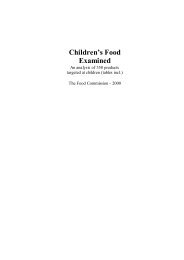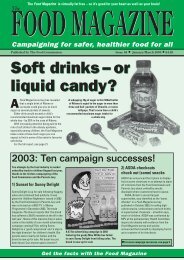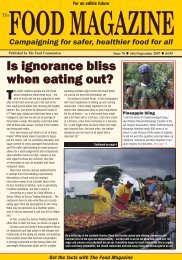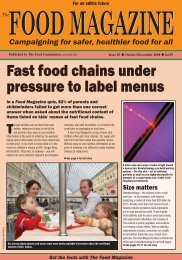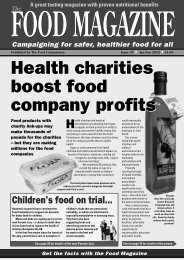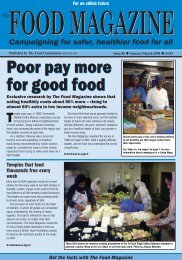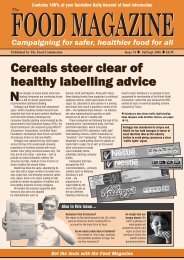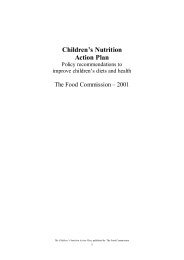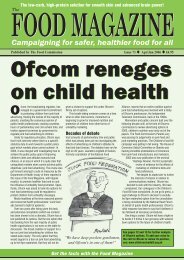Food Magazine - The Food Commission
Food Magazine - The Food Commission
Food Magazine - The Food Commission
Create successful ePaper yourself
Turn your PDF publications into a flip-book with our unique Google optimized e-Paper software.
health<br />
EC butter scandal<br />
continues<br />
In the late 1990s there was some<br />
consternation that the European<br />
<strong>Commission</strong>'s figures for butter production<br />
and consumption were misrepresenting the real<br />
situation.<br />
<strong>The</strong> European Court of Auditors was<br />
particularly anxious that Common Agricultural<br />
Policy (CAP) money was being wasted, and its<br />
investigation, published in 2000, showed there<br />
was considerable overproduction being<br />
encouraged by CAP support measures. <strong>The</strong> court<br />
was unhappy about the disposal measures for<br />
surplus butter, which effectively supported<br />
excess production while providing cheap<br />
ingredients for food manufacturers.<br />
<strong>The</strong>re was a clear market failure. While<br />
consumers were being urged by health<br />
professionals to cut their consumption of fatty<br />
foods, especially those rich in saturated fats (and<br />
butter is about as rich as it comes), the<br />
<strong>Commission</strong> was not only supporting overproduction,<br />
but was actively subsidising the<br />
surplus butter by selling it to industry at belowmarket<br />
costs. <strong>The</strong> industry happily pumped the<br />
extra butter into our food supply in the form of<br />
cakes, pastries, biscuits, ice cream and<br />
desserts.<br />
This is now history, surely Well, no, it isn't.<br />
We have taken a look at the agricultural<br />
figures for the last half decade and found that the<br />
situation remains as bad as ever it was.<br />
Consumers have reduced their purchases of<br />
butter to the lowest levels yet, but the EC's<br />
intervention purchases have been steadily rising.<br />
In 2003 (the latest published figures) consumers<br />
bought 1.2m tonnes of butter at normal prices,<br />
while the EC purchased into intervention another<br />
0.53m tonnes. <strong>The</strong> total being bought by the EC<br />
now amounts to nearly a third of all butter<br />
produced.<br />
And while some of the intervention butter is<br />
given to welfare schemes and non-profit bodies<br />
– for lucky pensioners, hospital<br />
patients and school children to<br />
be dosed up with<br />
saturated fat –<br />
the greatest<br />
amount by<br />
far is<br />
Butter trends 1998-2003 (% of total consumption) showing normal butter purchases<br />
(consumers), butter subsidised for social use (social) and butter sold cheaply to<br />
companies (industry)<br />
sold off to food processors. <strong>The</strong> latest figures<br />
show a record 490,000 tonnes of butter (and<br />
cream) being sold off, some 92% of the surplus.<br />
Milk production has become an intensive<br />
industry, requiring large amounts of home-grown<br />
and imported fodder, which in turn require large<br />
areas of land, water, pesticides and fuel. <strong>The</strong><br />
ecological 'footprint' of butter is especially high:<br />
the footprint of resources needed to produce a<br />
tonne of vegetables is less than one hectare, a<br />
tonne of milk needs between one and two<br />
hectares, a tonne of meat some 20 hectares, but<br />
a tonne of butter some 30 hectares. Cutting the<br />
butter surplus could reduce Europe's agricultural<br />
footprint by a massive 15 million hectares –<br />
about half of France's agricultural land.<br />
Source: <strong>The</strong> Agricultural Year 2004,<br />
European <strong>Commission</strong>, 2005.<br />
Buttery biscuits: Around half a<br />
million tonnes of subsidised butter<br />
and cream go into processed foods like<br />
these annually.



